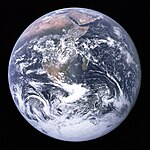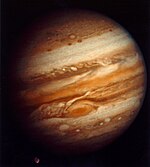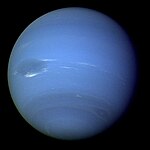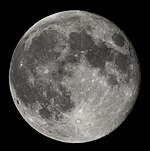 |
 |
 |
(From top to bottom)
|
Space exploration is the use of astronomy and space technology to explore outer space.[1] Physical exploration of space is conducted both by human spaceflights and by robotic spacecraft.
While the observation of objects in space—known as astronomy—pre-dates reliable recorded history, it was the development of large liquid-fueled rocket engines during the early 20th century that allowed physical space exploration to become a reality. Common rationales for exploring space include advancing scientific research, uniting different nations, ensuring the future survival of humanity and developing military/strategic advantages against other countries. Various criticisms of Space Exploration are sometimes made, generally on cost or safety grounds.
Space exploration has often been used as a proxy competition for geopolitical rivalries such as the Cold War. The early era of space exploration was driven by a "Space Race" between the Soviet Union and the United States; the launch of the first man-made object to orbit the Earth, the USSR's Sputnik 1, on October 4, 1957, and the first Moon landing by the American Apollo 11 craft on July 20, 1969 are often taken as the boundaries for this initial period. The Soviet space program achieved many of the first milestones under Sergey Korolyov and Kerim Kerimov, including the first human spaceflight (Yuri Gagarin aboard Vostok 1) in 1961, the first spacewalk (by Aleksei Leonov) in 1965, and the launch of the first space station (Salyut 1) in 1971. However, the first man-made objects to reach space were Nazi-Germany's V2 rockets, used as early as the Second World War.
After the first 20 years of exploration, focus shifted from one-off flights to renewable hardware, such as the Space Shuttle program, and from competition to cooperation as with the International Space Station.
From the 1990s onwards, private interests began promoting space tourism and now private space exploration of the Moon (see GLXP).
In the 2000s, China initiated a successful manned spaceflight program. Larger government programs have advocated manned missions to the Moon and possibly Mars sometime after 2010.
Contents[hide] |
[edit] History
- See also: Timeline of space exploration and Astronomy#History
[edit] First orbital flights
The first successful orbital launch was of the Soviet unmanned Sputnik (Satellite I) mission on October 4, 1957. The satellite weighed about 83 kg (184 pounds), and is believed to have orbited Earth at a height of about 250 km (150 miles). It had two radio transmitters (20 and 40 MHz), which emitted "beeps" that could be heard by any radio around the globe. Analysis of the radio signals was used to gather information about the electron density of the ionosphere, while temperature and pressure data was encoded in the duration of radio beeps. The results indicated that the satellite was not punctured by a meteoroid. Sputnik 1 was launched by an R-7 rocket. It incinerated upon re-entry on January 3, 1958.
This success led to an escalation of the American space program, which unsuccessfully attempted to launch Vanguard 1 into orbit two months later. On January 31, 1958, the U.S. successfully orbited Explorer 1 on a Juno rocket. In the meantime, the Soviet dog Laika became the first animal in orbit on November 3, 1957.
[edit] First human flights
The first human spaceflight was Vostok 1 (East 1), carrying 27 year old Russian cosmonaut Yuri Gagarin on April 12, 1961. The spacecraft completed one orbit around the globe, lasting about 1 hour and 48 minutes. Gagarin's flight resonated around the world; it was a demonstration of the advanced Soviet space program and it opened an entirely new era in space exploration — human spaceflight.
The U.S. first launched a person into space within a month of Gagarin's flight with the first Mercury flight, by Alan Shepard. Orbital flight was achieved by the United States when John Glenn's Mercury-Atlas 6 orbited the Earth on February 20, 1962.
Valentina Tereshkova, the first woman in space, orbited the Earth 48 times aboard Vostok 6 on June 16, 1963.
China first launched a person into space 42 years after the launch of Vostok 1, on October 15, 2003, with the flight of Yang Liwei aboard the Shenzhou 5 (Spaceboat 5) spacecraft.
[edit] Key people in early space exploration
The dream of stepping into the outer reaches of the Earth's atmosphere was driven by rocket technology. The German V2 was the first rocket to travel into space, overcoming the problems of thrust and material failure. During the final days of World War II this technology was obtained by both the Americans and Soviets as were its designers. The initial driving force for further development of the technology was a weapons race for inter-continental ballistic missiles (ICBMs) to be used as long-range carriers for fast nuclear weapon delivery, but in 1961 when USSR launched the first man into space, the U.S. declared itself to be in a "Space Race" with Russia.
- Konstantin Tsiolkovsky, Robert Goddard, Hermann Oberth and Reinhold Tilling laid the groundwork of rocketry in the early years of the 20th century.
- Wernher von Braun was the lead rocket engineer for Nazi Germany's World War II V-2 rocket project. In the last days of the war he led a caravan of workers in the German rocket program to the American lines, where they surrendered and were brought to the USA to work on U.S. rocket development. He acquired American citizenship and led the team that developed and launched Explorer 1, the first American satellite. Von Braun later led the team at NASA's Marshall Space Flight Center which developed the Saturn V moon rocket.
- Initially the race for space was often led by Sergey Korolyov, whose legacy includes both the R7 and Soyuz—which remain in service to this day. Korolev was the mastermind behind the first satellite, first man (and first woman) in orbit and first spacewalk. Until his death his identity was a closely guarded state secret; not even his mother knew that he was responsible for creating the Russian space program.
- Kerim Kerimov was one of the founders of the Soviet space program and was one of the lead architects behind the first human spaceflight (Vostok 1) alongside Sergey Korolyov. After Korolyov's death in 1966, Kerimov became the lead scientist of the Soviet space program and was responsible for the launch of the first space stations from from 1971 to 1991, including the Salyut and Mir series, and their precursors in 1967, the Cosmos 186 and Cosmos 188.[2][3]
Other key people included:
- Valentin Glushko held role of Chief Engine Designer for USSR. Glushko designed many of the engines used on the early Soviet rockets, but was constantly at odds with Korolyov.
- Vasily Mishin, Chief Designer working under Sergey Korolyov and one of first Soviets to inspect the captured German V2 design. Following the death of Sergei Korolev, Mishin was held responsible for the Soviet failure to be first country to place a man on the moon.
- Bob Gilruth, was the NASA head of the Space Task Force and director of 25 manned space flights. Gilruth was the person who suggested to John F. Kennedy that the Americans take the bold step of reaching the Moon in an attempt to reclaim space superiority from the Soviets.
- Christopher C. Kraft, Jr., was NASA's first flight director and oversaw development of Mission Control and associated technologies and procedures.
[edit] Future of Space Exploration
Since few years, several plans for space exploration have been announced.
The major paradigm is that today, not only governmental entities do have space exploration objectives but also the private sector.
[edit] Private Ventures
Today, dozens of private projects have been announced.
Among them, Bigelow Aerospace already has made 2 orbital payload deliveries,and aims to build the first in-orbit hotel within the upcoming decade.
The Google Lunar X-Prize also aims to initiate private space exploration by offering a first and second place prize totaling $30 million for the first privately funded robotic lunar landing. Companies such as White Label Space or Astrobotics are studying missions concepts as part or not of the official teams.
Space Exploration Technologies Corp performed a successful flight of the Falcon 1 launch vehicle [4].
[edit] Targets of exploration
[edit] Astrobiology
Astrobiology is the interdisciplinary study of life in the universe, combining aspects of astronomy, biology and geology.[5] It is focused primarily on the study of the origin, distribution and evolution of life. It is also known as exobiology (from Greek: έξω, exo, "outside").[6][7][8] The term "Xenobiology" has been used as well, but this is technically incorrect because its terminology means "biology of the foreigners".[9] Astrobiologists must also consider the possibility of life that is chemically entirely distinct from any life found on earth.[10]

[edit] The Sun
While the Sun will probably never be physically explored, one of the reasons for going into space includes knowing more about the Sun. Once above the atmosphere in particular and the Earth's magnetic field, this gives access to the Solar wind and infrared and ultraviolet radiations that cannot reach the surface of the Earth. The Sun generates a lot of space weather and can even effect mankind's power generation and transmission systems on Earth.

[edit] Mercury
The exploration of Mercury has taken only a minor role in the space interests of the world. It is the least explored inner planet (JHU/APL, 2006). As of January 2008, the Mariner 10 and MESSENGER missions have been the only missions that have made close observations of Mercury. MESSENGER made a fly-by of Mercury on 14 January 2008, to further investigate the observations made by Mariner 10 in 1975 (Munsell, 2006b). A third mission to Mercury, BepiColombo, is to include two probes. BepiColombo is a joint mission between Japan and the European Space Agency. MESSENGER and BepiColombo are intended to gather complementary data to help scientists understand many of the mysteries discovered by Mariner 10's flybys.
Flights to other planets within the Solar System are accomplished at a cost in energy, which is described by the net change in velocity of the spacecraft, or delta-v. Due to the relatively high delta-v to reach Mercury and its proximity to the Sun, it is difficult to explore and orbits around it are rather unstable.

[edit] Venus
Venus was the first target of interplanetary flyby and lander missions and, despite one of the most hostile surface environments in the solar system, has had more landers sent to it, nearly all from the Soviet Union, than any other planet in the solar system. The first successful Venus flyby was the American Mariner 2 spacecraft, which flew past Venus in 1962. Mariner 2 has been followed by several other flybys by multiple space agencies often as part of missions using a Venus flyby to provide a gravitational assist en route to other celestial bodies. In 1967 Venera 4 became the first probe to enter and directly examine the atmosphere of Venus. In 1970 Venera 7 became the first successful lander to reach the surface of Venus and by 1985 it had been followed by 8 additional successful Soviet Venus landers which provided images and other direct surface data. Starting in 1975 with the Soviet orbiter Venera 9 some 10 successful orbiter missions have been sent to Venus including later missions which were able map the surface of Venus using radar to pierce the obscuring atmosphere.

[edit] Earth
The Earth is by far the most explored object in the Solar System.
The Americans were the first to discover the existence of the Van Allen belts around the Earth. These belts contain radiation trapped by the Earth's magnetic fields, which currently prevent habitable space stations from being placed above 1000km.
The Earth is explored and observed by Earth observation satellites. The hole in the ozone layer was found from an artificial satellite that was exploring Earth's atmosphere.
[edit] Earth's Moon
The Russians were the first to take pictures of the far side of the moon; something that was never visible to humans. It was discovered that the far side was more heavily cratered.
The American Apollo missions returned rocks from the moon that support the theory that the Moon was once part of the Earth.


[edit] Mars
The exploration of Mars has been an important part of the space exploration programs of the Soviet Union (later Russia), the United States, Europe, and Japan. Dozens of robotic spacecraft, including orbiters, landers, and rovers, have been launched toward Mars since the 1960s. These missions were aimed at gathering data about current conditions and answering questions about the history of Mars. The questions raised by the scientific community are expected to not only give a better appreciation of the red planet but also yield further insight into the past, and possible future of Earth.
The exploration of Mars has come at a considerable financial cost with roughly two-thirds of all spacecraft destined for Mars failing before completing their missions, with some failing before they even begin. Such a high failure rate can be attributed to the complexity and large number of variables involved in an interplanetary journey, and has led researchers to jokingly speak of The Great Galactic Ghoul [11] which subsists on a diet of Mars probes. This phenomenon is also informally known as the Mars Curse. [12]

[edit] Jupiter
The exploration of Jupiter has consisted solely of a number of automated NASA spacecraft visiting the planet since 1973. A large majority of the missions have been "flybys", in which detailed observations are taken without the probe landing or entering orbit; the Galileo spacecraft is only one to have orbited the planet. As Jupiter is projected to have only a relatively small rocky core and no real solid surface, a landing mission is impossible.
Reaching Jupiter from Earth requires a delta-v of 9.2 km/s,[13] which is comparable to the 9.7 km/s delta-v needed to reach low Earth orbit.[14] Fortunately, gravity assists through planetary flybys can be used to reduce the energy required at launch to reach Jupiter, albeit at the cost of a significantly longer flight duration.[13]
Jupiter has over 60 known moons many of which relatively little is known.

[edit] Saturn
The exploration of Saturn has been solely through unmanned spacecraft launched by NASA including one mission planned and executed in cooperation with other space agencies. Like all gas giants, there is no solid surface for a probe to land on. Most missions therefore have been flybys with the exception of the joint NASA/ESA/ASI Cassini–Huygens spacecraft currently in orbit.
Saturn has at least 60 satellites, although the exact number is debatable since Saturn's rings are made up of vast numbers of independently orbiting objects of varying sizes.

[edit] Uranus
The exploration of Uranus has been solely through the Voyager 2 spacecraft, with no other visits currently planned. The closest approach to Uranus occurred on January 24, 1986. Voyager 2 discovered 10 previously unknown moons; studied the planet's unique atmosphere, caused by its axial tilt of 97.77°; and examined its ring system.


[edit] Neptune
The exploration of Neptune has only begun with one explorer, Voyager 2, which visited on August 25, 1989. The possibility of a Neptune Orbiter is being discussed, yet other than that, no other missions have been given serious thought. As Neptune is a gas giant and has no solid surface, a surface mission such as a lander or rover is impossible. Voyager 2 found that Neptune has the fastest winds of any planet in the solar system, measured as high as 2,100 km/h.[15] Neptunes largest moon Triton is thought to be a captured Kuiper belt object.[16]

[edit] Pluto
The dwarf planet Pluto (considered a planet until the IAU redefinition of "planet" in October 2006[17]) presents significant challenges for spacecraft because of its great distance from Earth (requiring high velocity for reasonable trip times) and small mass (making capture into orbit very difficult at present). Voyager 1 could have visited Pluto, but controllers opted instead for a close flyby of Saturn's moon Titan, resulting in a trajectory incompatible with a Pluto flyby. Voyager 2 never had a plausible trajectory for reaching Pluto.[18]
Despite its reclassification, as the lead and nearest member of a new and growing class of distant icy bodies of intermediate size, in mass between the remaining eight planets and the small rocky objects historically termed asteroids (and also the first member of the important subclass, defined by orbit and known as "Plutinos"), Pluto continues to be of great interest. After an intense political battle, a mission to Pluto dubbed New Horizons, was granted funding from the US government in 2003.[19] New Horizons was launched successfully on January 19, 2006.
In early 2007 the craft made use of a gravity assist from Jupiter. Its closest approach to Pluto will be on July 14, 2015; scientific observations of Pluto will begin 5 months prior to closest approach and will continue for at least a month after the encounter.
[edit] Asteroids
Until the advent of space travel, objects in the asteroid belt were merely pinpricks of light in even the largest telescopes, their shapes and terrain remaining a mystery. Several asteroids have now been visited by probes, the first of which was Galileo, which flew past two: 951 Gaspra in 1991, followed by 243 Ida in 1993. Both of these lay near enough to Galileo's planned trajectory to Jupiter that they could be visited at acceptable cost. The first landing on an asteroid was performed by the NEAR Shoemaker probe in 2000, following an orbital survey of the object. The dwarf planet Ceres and the asteroid 4 Vesta are targets of NASA's Dawn mission, launched in 2007 September.
[edit] Rationales
- See also: Space advocacy
The research that is conducted by national space exploration agencies, such as NASA and the RKA, is among the reasons supporters cite to justify government expenses. Some even claim that space exploration is a necessity to mankind and that staying on our home planet will lead us to extinction. Some of the reasons are lack of natural resources, comets, nuclear war, worldwide epidemic etc. Stephen Hawking, renowned British theoretical physicist, said that "I don't think the human race will survive the next thousand years, unless we spread into space. There are too many accidents that can befall life on a single planet. But I'm an optimist. We will reach out to the stars."[20]
NASA has produced a series of Public Service Announcement videos supporting the concept of space exploration.[21]
Overall, the public remains largely supportive of both manned and unmanned space exploration. According to an Associated Press Poll conducted in July 2003, 71% of U.S. citizens agreed with the statement that the space program is "a good investment", compared to 21% who did not.[22]
Arthur C. Clarke (1950) presented a summary of motivations for the human exploration of space in his non-fiction semi-technical monograph Interplanetary Flight [23]. In it he argued that humanity's choice is essentially between expansion off the Earth into space, versus cultural (and eventually biological) stagnation and death.
[edit] Opposition
Critics, such as the late physicist and Nobel prize winner Richard Feynman have contended that space travel has never achieved any major scientific breakthroughs.[24]
[edit] Related topics
[edit] Spaceflight
Spaceflight is the use of space technology to fly a spacecraft into and through outer space. Spaceflight is very typically a component of space exploration, but also supports commercial activities, satellite launches.
[edit] Space colonization
Space colonization, also called space settlement and space humanization, would be the permanent autonomous (self-sufficient) human habitation of locations outside Earth, especially of natural satellites or planets such as the Moon or Mars, using significant amounts of In-Situ Resource Utilization.
Many past and current concepts for the continued exploration and colonization of space focus on a return to the moon as a "stepping stone" to the other planets, especially Mars. At the end of 2006 NASA announced they were planning to build a permanent moon base with continual presence by 2024.[25]












No comments:
Post a Comment